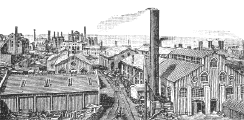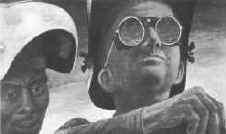| |

|
 24.
Daguerreotype occupational portrait of three railroad
workers on a handcar, ca. 1850-1860. (Daguerreotype:
Library of Congress) 24.
Daguerreotype occupational portrait of three railroad
workers on a handcar, ca. 1850-1860. (Daguerreotype:
Library of Congress)
|
| |
|
|
The
maintenance crews working in the 1865 structure would have had the
dubious pleasure of working long hours with water and grease washing
around their feet. The crowned profile of the 1902 pits insured
that the industrial effluence ran to the sides of the pit and, hence
by side channels, to a drain at the inner end of the pits. While
the 1865 pits also sloped to a drain at their inner end, the convex
floors would have denied the crew the benefits of a dry and secure
footing in the center of the pits— precisely where it would
have been most appreciated.
The extensive below ground remains of both the
1902 and, particularly, the 1865 roundhouses surprised park staff
and project designers. Close coordination between archeological
and design staff allowed for last minute changes in construction
plans which have insured that portions of pits from both periods
are preserved, in juxtaposition, as an in-ground interpretive
display.
|






 23. Cross-section
of an excavated 1865 inspection pit. Note the concave configuration
of the pit floor. (Drawing after: LBA)
23. Cross-section
of an excavated 1865 inspection pit. Note the concave configuration
of the pit floor. (Drawing after: LBA)